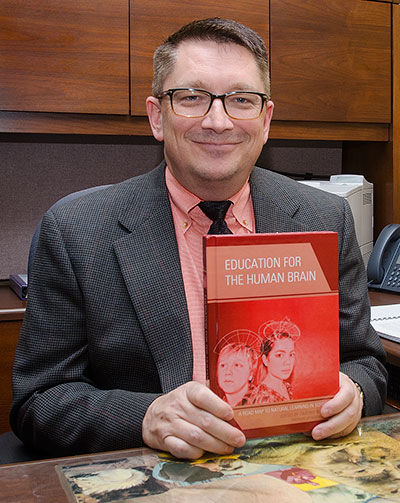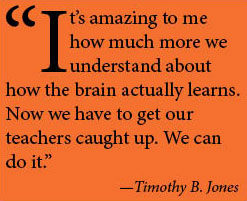Prof Makes Education 'Memorable' With Book On 'Natural Learning'
Dec. 10, 2013
SHSU Media Contact: Jennifer Gauntt
Story By: Kim Kyle Morgan
 When you consider the fact that in 1969 there were only approximately 500 neuroscientists around the world, it's safe to say the field of neuroscience is relatively new.
When you consider the fact that in 1969 there were only approximately 500 neuroscientists around the world, it's safe to say the field of neuroscience is relatively new.
Today, there are more than 60,000 neuroscientists, and this has resulted in an explosion of knowledge about the brain.
But, perhaps ironically, the latest science proves that when it comes to how we learn, Mother Nature has known best from day one.
"We call it 'natural learning,' teaching how the brain naturally learns, as opposed to forcing passive learning," said Timothy B. Jones, associate professor in Sam Houston State University’s educational leadership and counseling department. "Even the best lecture you ever heard simply deposits information into your short-term memory, not your long-term memory. Just think about all the learning that goes on in the United States that is really nothing more than a lecture, with the student passively sitting, listening to the teacher. And then we act surprised around test time when the child doesn't remember most of it, when actually it's a very predictable outcome."
Natural learning, Jones said, has been relatively slow to be implemented in the U.S., although it's widespread in many other parts of the world. To this, Jones attributes the fact that American students continue to lose ground in math and science.
He writes about it in his book Education for the Human Brain: A Road Map to Natural Learning in Schools.
"There are lots of books written about brain-compatible learning, but they're written for teachers," Jones said. "There's nothing to retrain educational leaders on how to facilitate the development of these kinds of schools. That's the purpose of my book. But it's also written in layman's terms so it's not only for leaders; I wrote it with parents and community members in mind because I believe the way we get schools developed in this direction is going to come from communities that demand better methods in the schools their kids are in."
Education for the Human Brain is broken into three sections.
"You can't do this if you're lacking any one of those three components," Jones said.
First is exploration, which explains the science behind brain-compatible learning; second is inspiration, which features case studies and results from projects in the Dallas and Aldine school districts; and third is the road map—how to plan for and implement the work ahead.
"It doesn't take money, new buildings, bond issues, a new faculty or any of that," Jones said. "What it does take is commitment from teachers. We can teach them how to teach to the long-term memory. We can take the lessons they are already passively delivering and help develop the curriculum into a brain-compatible way. It requires abandoning some very age-old traditions in instruction, which is a very scary proposition for people who have never been taught to teach in any other way."
The greatest requirement, it seems, is willingness to join the journey.
"We have to get everybody with a stake in schools to work together—parents, grandparents, teachers, board members, community members, business owners…," Jones said. "The only way real changes have occurred in schools has been when it was driven by the community and stakeholders."
Education for the Human Brain has been well received, selling out at book-signing events around Texas. It's also well received by Jones' colleagues, as is apparent in reviews:
"Much has been written about brain-based learning, but most fall short when looking for a comprehensive treatment of the topic," writes Fred C. Lunenburg, professor of education at SHSU. "Jones provides a complete treatment of the subject."
 "Jones and his colleagues offer insights into a most powerful tool for transforming instruction and learning—the brain," writes George W. Moore, associate professor in SHSU’s educational leadership and counseling department. "I will use this book in my instructional theory class."
"Jones and his colleagues offer insights into a most powerful tool for transforming instruction and learning—the brain," writes George W. Moore, associate professor in SHSU’s educational leadership and counseling department. "I will use this book in my instructional theory class."
The foreword is written by Geoffrey Caine, a man Jones said truly motivates him. Caine is the author of Education on the Edge of Possibility, which details the results of brain-based learning and how its implementation reduces the clash of classroom reality and typical learning theory.
"They had worked with two schools in the U.S. and had absolutely phenomenal results," said Jones, who, in 1995, was inspired to open his own "school within a school" based on Caine's principles.
That school within a school was at Thomas J. Rusk Middle School in Nacogdoches ISD. It was "enormously successful," Jones said, and generated media attention across the nation.
But Jones left that success behind to focus on the bigger picture.
"I decided to spend my time teaching others what we had done and how to do it," Jones said.
Today, Jones has a second book under contract, with a working title of Returning Public Schools in America to Greatness.
"For about 20 years, we've had an attack on public education," Jones said. "But now we have an attack on public educators. (The discourse is that) It's no longer the schools are bad, but the teachers are bad."
Jones said that as with anything, there are always a few rotten apples in the bunch, but his experiences in public elementary, middle and high schools have been positive. So positive, in fact, that when he was a little boy, his vision of superheroes wasn't Batman or Spiderman. It was his teachers.
"I was in awe of being around them," Jones said. "And I wanted to be one of them."
After receiving a bachelor's degree in political science and business administration from Stephen F. Austin in 1983, Jones was a middle school teacher for Clear Creek ISD.
He went on to earn a master's degree in educational management from University of Houston-Clear Lake, followed by a doctor of education degree in educational leadership from Stephen. F. Austin in 2000.
Jones joined the faculty at SHSU in 2008, where he is thankful for continued support in his interest about brain-compatible learning.
"It's amazing to me how much more we understand about how the brain actually learns," Jones said. "Now we have to get our teachers caught up. We can do it."
- END -
This page maintained by SHSU's Communications Office
Associate Director: Julia May
Manager: Jennifer Gauntt
Located in the 115 Administration Building
Telephone: 936.294.1836; Fax: 936.294.1834
Please send comments, corrections, news tips to Today@Sam.edu.

 SamWeb
SamWeb My Sam
My Sam E-mail
E-mail

